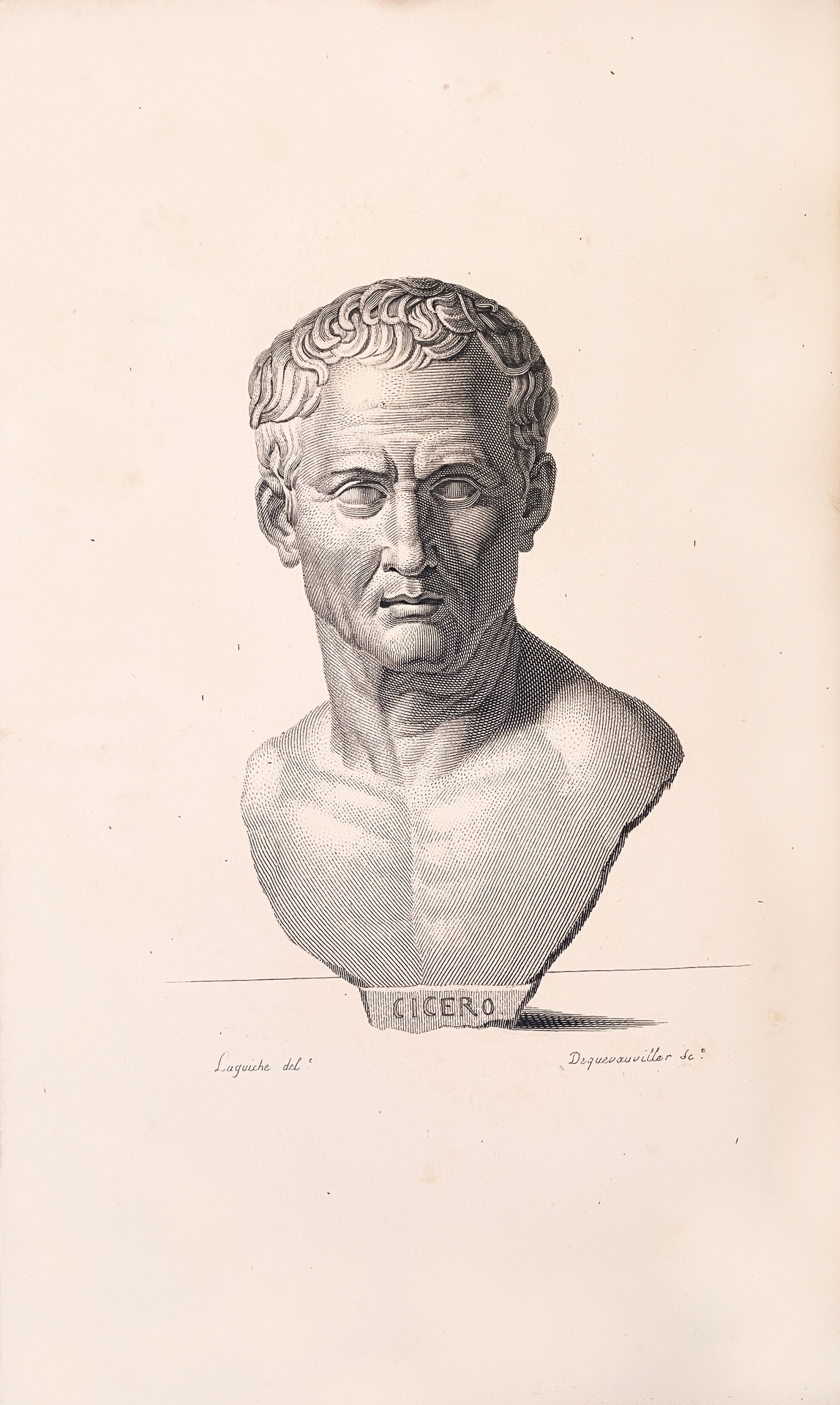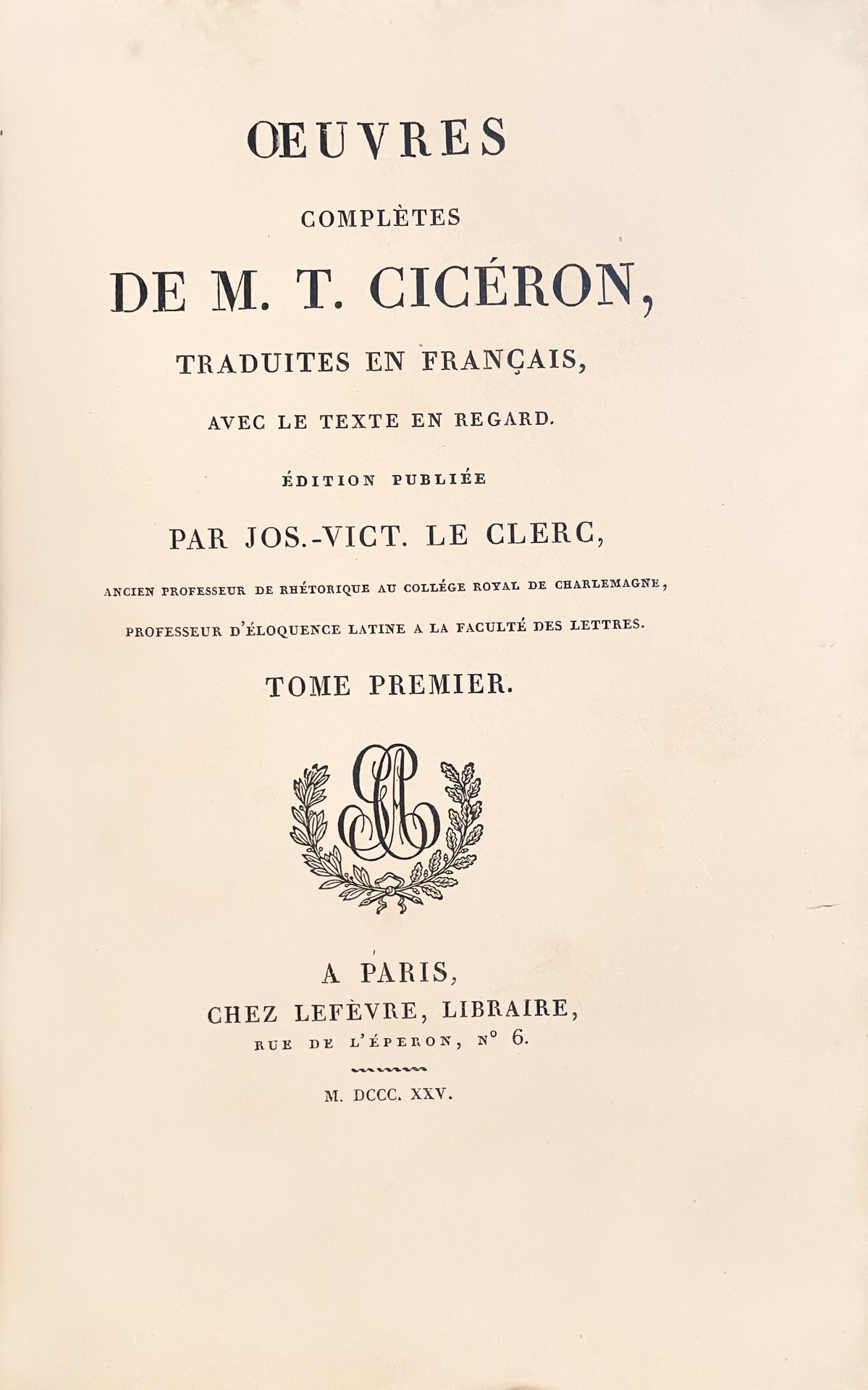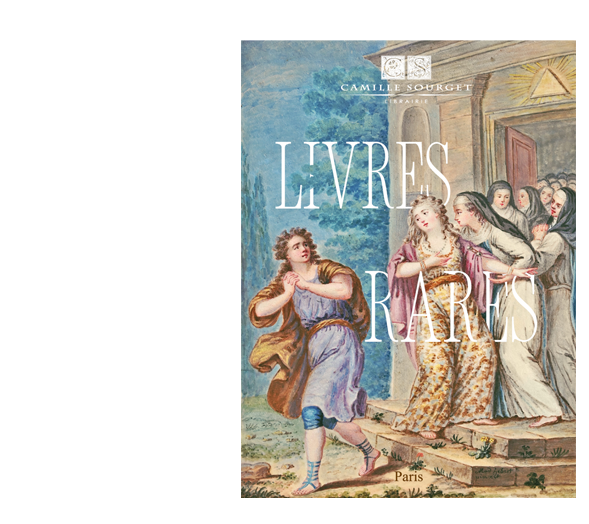Paris, Lefèvre, 1821-1825.
30 8vo volumes [230 x 146 mm]. A portrait of Cicero as frontispiece.
Straight-grained red morocco from Simier, three volumes (1-2 et 30) signed “Simier. R. du roi”, covers decorated with a rich border composed of gilt and blind-stamped fillets with fleurons in the corners, with the arms of Marie-Caroline de Bourbon-Sicile, Duchess de Berry (1798-1870) in the center of the covers, (Olivier 2554 tool n° 2), spine ribbed abundantly decorated with gilt and blind-stamped patterns, gilt inner border, gilt edges. Contemporary armorial binding signed by Simier, the king’s binder.
First collective edition of the translation of Cicero’s Works into French.
It is the first one quoted by Brunet (II: 49-50) that he describes like this:
“This edition, outstanding in many aspects, deserves the success it got. The text presents a new recension, for which the author made use of the variations of a large number of manuscripts, and of the help that philology abundantly provided him. Latin notes, placed at the bottom of the text report the reasons that made him adopt some lessons over others. Translations of rhetoric works, nearly all of them being new, are due to Mr. J. – V. Le Clerc, Liez, Gaillard and Burnouf. The ones of the speeches have for author Messrs. Burnouf, Gueroult, Naudet, Binet, Goubaux and the abbot Auger: the work of the latter has been revised by the editor who also revised all antique translations gathered for his collection. For the familial letters and the letters to Atticus, Prevost and de Mongault’s translations have been preserved; but the ones of the letters to Quintus, to Brutus, etc., are by Mr. Le Clerc. In philosophical works we find the translations by Regnier Desmarais, d’Olivet and by pres. Bouhier, as well as a part by Morabin, and the Academic by de Castillon. Mr. Le Clerc has translated the treatise concerning Divination and Fate; the Laws are by Mr. Ch. de Rémusat, and the treatise on Obligations is a translation by Gallon-la Bastide.
All the fragments freshly collected, and that are gathered here for the first time, have for translator Mr. Le Clerc himself. Besides, this learned editor has enlarged his edition with a preliminary speech, a Life by Cicero, translated by Plutarch, and coming from supplements partly extracted from Middleton. In the 30th volume are several indexes, composed after the ones by Ernesti. Finally Mr. Le Clerc has joined in every of Cicero’s work historical, philological and literary introductions, and critical and explanatory notes of great interest. We shall not forget to mention the Bibliographical record on the editions and French translations of Cicero’s Works, by C. Breghot du Lut and A. Péricaud; it is a peculiar piece, bound at the end of the first volume.”
“Cicero (106-43 B.C) is surely one of the greatest figures of Ancient Rome, and the influence of his mind and work, that contributed to spread the culture of Antiquity throughout the centuries, remained alive.” Concetto Marchesi.
“[Cicero] with the superiority of his intelligence, the greatness of his acts, of his position, of his life and reputation, not only thanks to the fact that he brought, but also trained and improved the language but also Latin literature, eloquence and philosophy, by bringing them to Greece, thanks to the fact that he was undoubtedly, the first greatest Latin author, in any genre, was mastering so well the others that it is said that Latin written language had the reputation to be entirely included in his works, and that they were considered as Academy and Dictionary…”. Leopardi.
A magnificent royal copy from the luxury issue on very large vellum paper covered with astonishing bindings in full contemporary red morocco decorated with the arms of the Duchess of Berry, signed three times, on parts 1-2 and 30, by Simier the king’s binder.
Marie-Caroline-Ferdinande-Louise de Bourbon-Sicile, daughter of Ferdinand I, king of Sicily, and of Marie-Clémentine, archduchess of Austria, born in Naples on November 5th 1798, married on June 17th 1816, Charles-Ferdinand d’Artois, duke of Berry, second son of the future Charles X, that was murdered on February 13th 1820. The duchess of Berry, widow at 22, dedicated herself to the education of their two children, Louise-Marie-Thérèse d’Artois and Henri-Charles-Ferdinand-Marie-Dieudonné, duke of Bordeaux, born after his father’s death; as a very brave woman, she tried in 1832 to foment in Vendee a legitimate uprising that failed; betrayed on November of the same year, she was imprisoned at the citadel of Blaye where she gave birth to a daughter she had with the count Hector Lucchesi-Palli, that she secretly married in 1831; released on June 1833, she was kept aside by the royal family and was discharged of his son’s education. She lived in Venice and died on April 1870 at the castle of Brunsee in Styria.
This princess, with very developed artistic tastes, had first constituted in her castle of Rosny, near Mantes, a luxurious library, remarkable as for the selection of editions, the richness of the bindings and the importance of the manuscripts it included, then after her many misfortunes, she had constituted a cabinet of reading composed of the major contemporary authors that she particularly appreciated in his Austrian retreat of Brunsee: Balzac, Dumas, Sue, etc. This volumes made for reading were covered of a half-calf binding, placed on the shelves of the library of Brunsee and enriched with the ex-libris “Brunsee – A l’index – Ouvrage n° – Volume n° – Armoire – Rayon – Place.” Edges of these volumes are in a charming yellow color.
An outstanding copy, elegantly bound by Simier for the Duchess of Berry’s collection, each volume bearing on both covers her coat of arms.
Provenance: form the Duchess of Berry’s collection (arms stamped in the center of the covers) – Baron Northwick (heraldic ex-libris engraved bearing the moto “par ternis supar”. Sale of the baron Northwick’s collection, Northwick Park, Christie’s May 26th 1965).





